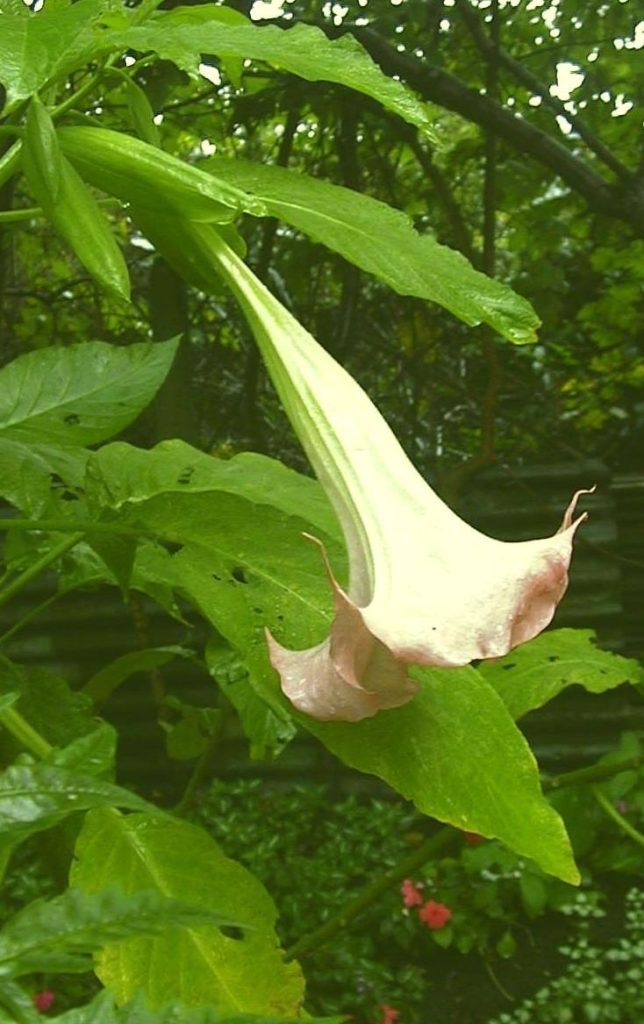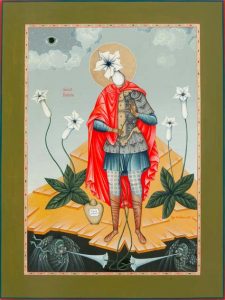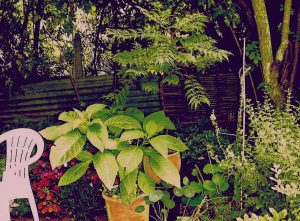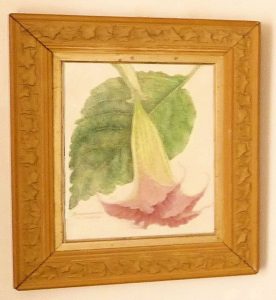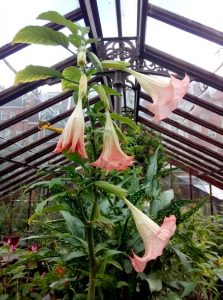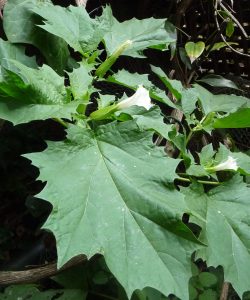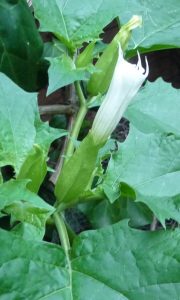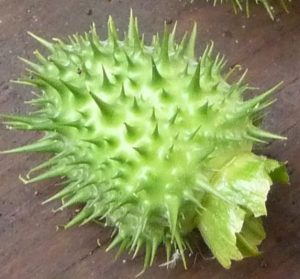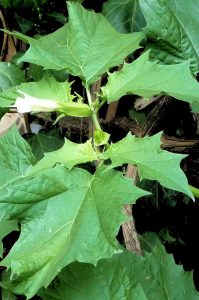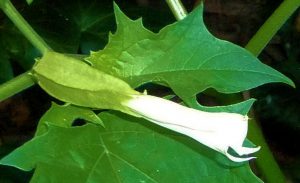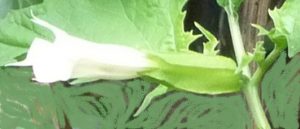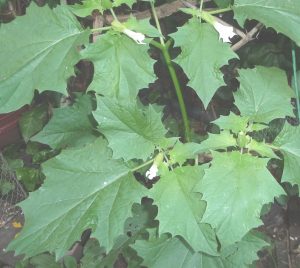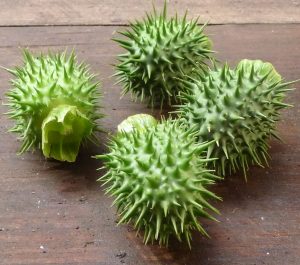ANGEL’S TRUMPETS, DATURA (Brugmansia suaveolens)
S E Brazil
This plant, formerly known as Datura, is a tropical shrub or small tree. Large fragrant flowers (SOFT PINK) emerge from buds the size of small cigars & dangle downwards.
Do not put the plant in full sun. It does best where it has room for its roots to grow. Do not use tap water – use ‘seasoned’ water which has sat in a bucket for at least 24 hrs to let any chemicals evaporate. A heavy feeder during the growing season. Will overwinter (in North Carolina) if given protection from the cold with leaves or mulch piled up at the base of the plant. It will die back to the ground but usually come back in spring.
North Carolina Extension Gardener Plant Toolbox – https://plants.ces.ncsu.edu/plants/brugmansia/
Our Angels’ Trumpets came from the old Woolworth’s at the Angel, Islington. Labelled ‘patio plant Datura’, it has since been reclassified as ‘Brugmansia’ with six other species : all have large trumpets opening downwards. Nine smaller species with trumpets opening upwards are now ‘Datura’.
It was a bare-rooted stick in a pot, but the photo of a fabulous trumpet flower on its plant tag convinced me that it would be beautiful on the balcony of my previous flat.. Surely bees visiting the Nasturtiums would revel in those trumpet flowers. The plant tag did not cover most of the above advice from North Carolina, but I did manage to keep the plant alive for 5 years on a balcony in North London.
 The balcony faced west, its floor over the ceiling of the flat below. The Datura was in full sun for hours, not recommended. And it was watered with tap water.
The balcony faced west, its floor over the ceiling of the flat below. The Datura was in full sun for hours, not recommended. And it was watered with tap water.
In spite of that the plant grew to quite a size, with stems over an inch thick & lush, exotic leaves. It became important to birdlife – birdhouses on the wall were homes to sparrows, who perched on its thick stems. The flowers were spectacular, but they brought no bees. At night the trumpets gave out a sweet, strong perfume, but I saw no moths.
For five years the Datura lived on the balcony. Following instructions, it was cut down as winter approached & covered with plastic on nights when frost was forecast. Left to its own devices, it wanted to grow to at least five feet in diameter.
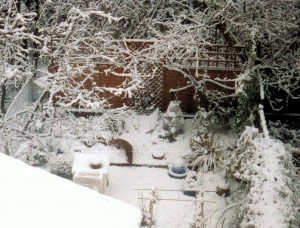
Fox on bank, snow in garden, on tree branches, little woodland behind, probably a last view of Datura wrapped in plastic.
The Datura came to Highbury in springtime 2001 in its very large container, & spent summer in the garden, surrounded by Sumac, Busy Lizzies, Nasturtiums… It looked strong & healthy, with the little woodland behind. The great leaves appeared as before, & the flower trumpets looked happy in the plant’s new surroundings.
As winter approached, the plant’s leaves were, as usual, removed & its stems cut back. It was then covered with heavy plastic. But one frosty night an unknown someone (rodent/ fox) chewed a hole in the plastic which allowed the cold air to reach the plant… It did not survive.
I’ve seen two sizeable Angel’s Trumpet shrubberies growing in North London front gardens, with YELLOW trumpets visited by many bees… Bees’ Favourites! One near Nag’s Head off Holloway Road, & one in Turnpike Lane. Perhaps they had mild winters in which to get their roots down when first planted out, & their placement in relation to neighbours’ shrubs, sunshine, houses serving as windbreaks, etc. gives them a sheltered position. But the bees were all over them… Hope to get a photo.
Other names: Floripondio, Maikoa, Moon Flower, Thorn apple, Tree Datura
Toxicity
Every part of the Angel’s Trumpet is toxic, with confusion, delirium & hallucinations the most common symptoms. In her gardening column for The Observer, Vita Sackville-West wrote of the Datura growing round the Equator:
“Nor had I ever been sufficiently grateful for not living in an island where the local burglar blows the pollen of datura in through your open window by means of a blowpipe and helps himself to your possessions while you lie temporarily insensible’. Vita Sackville-West, THE ILLUSTRATED GARDEN BOOK,
A New Anthology by Robin Lane Fox, Michael Joseph, London, 1986.
http://www.thepoisongarden.co.uk/atoz/datura_suaveolens.htm
www.gardeningknowhow.com/ornamental/trees/brugmansia
2020 DATURA STRAMONIUM (Jimson Weed)
A sizeable plant with large toothed leaves appeared in the wild area by the back fence during lockdown. Its WHITE flowers resembled the Angel’s Trumpets that had succumbed to winter in 2001. Its leaves, however, had a more dramatic edge to them, deeply toothed and scalloped. Internet research suggested that a seed had come from bird droppings or mixed birdseed in nearby feeders. This was perhaps an exotic gift from the universe…
It was Datura stramonium, a plant found round the world, with highest numbers in Mexico & Central America. Anyone working with this plant is advised to wear gloves. It is poisonous to dogs & horses; animals will not eat it.
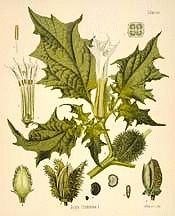 Narcotic : The Flying Ointment
Narcotic : The Flying Ointment
‘Thorn apple reached Northern Europe from India in the later Middle Ages, although it is mentioned in medieval Arabic texts at an earlier date.. Along with other plants in the nightshade family, datura was an active ingredient in the famous “flying ointment” used by European witches, a preparation that produced the illusion and sensation of transport through the air.
Datura and other such narcotic agents were applied topically; it was well recognized that it was extremely dangerous to ingest so poisonous a plant. The fifteenth-century herbal Hortus Sanitatis classes datura as cold in the fourth degree, a classification shared with other dangerous plants like opium poppy and poisonous mushrooms. Museum of Modern Art Cloisters
A Modern Herbal 1931
‘Its seeds are very retentive of life, and being often in the earth put on shipboard for ballast, from one country to another, the plant is thus propagated in all regions, and it is now spread throughout the world, except in the colder or Arctic regions.
‘In Great Britain, it is only occasionally found and can scarcely be considered naturalized here, though it is sometimes met with in the south of England, generally in rich, waste ground, chiefly near gardens or dwellings. It is sometimes grown in private gardens in England as an ornamental plant. It was cultivated in London towards the close of the sixteenth century.’ http://A Modern Herbal/Thornapple Maud Grieve, 1931 https://www.botanical.com/botanical/mgmh/t/thorna12.html
 ‘stramonium has become a cosmopolitan weed in the warm regions of North, Central and South America, Europe, Asia, Africa, Australia and New Zealand. It is now found throughout almost all the USA except for the north-west and northern great plains.’ google
‘stramonium has become a cosmopolitan weed in the warm regions of North, Central and South America, Europe, Asia, Africa, Australia and New Zealand. It is now found throughout almost all the USA except for the north-west and northern great plains.’ google
Wikipedia‘s detailed article about this weed includes photos of its thorny seed-bearing globes (thornapples) & anecdotes about its hallucinogenic effects. English soldiers used it in a salad in 1676 while in the colonies to quell ‘Bacon’s Rebellion’:
‘The James-Town Weed (which resembles the Thorny Apple of Peru, and I take to be the plant so call’d) is supposed to be one of the greatest coolers in the world. This being an early plant, was gather’d very young for a boil’d salad, by some of the soldiers sent thither to quell the rebellion of Bacon (1676); and some of them ate plentifully of it, the effect of which was a very pleasant comedy, for they turned natural fools upon it for several days: one would blow up a feather in the air; another would dart straws at it with much fury; and another, stark naked, was sitting up in a corner like a monkey, grinning and making mows [grimaces] at them; a fourth would fondly kiss and paw his companions, and sneer in their faces with a countenance more antic than any in a Dutch droll.
In this frantic condition they were confined, lest they should, in their folly, destroy themselves—though it was observed that all their actions were full of innocence and good nature. Indeed, they were not very cleanly; for they would have wallowed in their own excrements if they had not been prevented. A thousand such simple tricks they played, and after eleven days returned themselves again, not remembering anything that had passed.’
Puppies & small children can be at risk from this plant, but its unpleasant odour & noxious taste generally keep pets & other animals from eating it. The Pet Safe Garden . Los Angeles Timeshttps://www.latimes.com/archives/la-xpm-1990-12-23-re-9529-story.html
Traditional Medicine
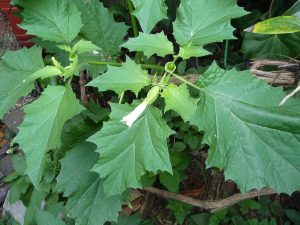
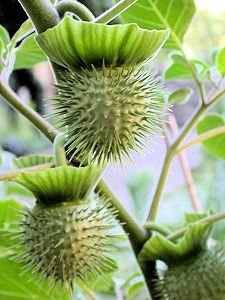 ‘The god lord Shiva was known to smoke Cannabis and Datura. People still provide the small thorn apple during festivals and special days as offerings in Shiva icons at temples. An extract made from the leaves is taken orally for the treatment of asthma and sinus infections, and stripped bark is applied externally to treat swellings, burns and ulcers.’ Pharmacological Properties of Datura Stramonium L. as a potential medicinal tree: An overview
‘The god lord Shiva was known to smoke Cannabis and Datura. People still provide the small thorn apple during festivals and special days as offerings in Shiva icons at temples. An extract made from the leaves is taken orally for the treatment of asthma and sinus infections, and stripped bark is applied externally to treat swellings, burns and ulcers.’ Pharmacological Properties of Datura Stramonium L. as a potential medicinal tree: An overview
‘In China a Taoist legend refers to the plant as the flower of one of the pole stars. The Chinese customarily mixed Datura with cannabis and wine, and legend had it that if the person gathering the plant had a pleasant disposition at the time, this would be reflected in the behavior of all who drank from it, but if the gatherer had been sad, so would be all who drank the wine. Datura was also used to treat colds and nervous conditions.’ American Botanical Council, HerbalGram: Jimson Weed: History, Perceptions, Traditional Uses, and Potential Therapeutic Benefits of the Genus Datura
“To learn how to use this plant read Carlos Castanada’s The Teachings of Don Juan: A Yaqui Way of Knowledge… The plant was used by the priests of Apollo to produce prophecies. Gypsies, who introduced the plant into Europe in the sixteenth century, smoked the plant for intoxicating visions. Witches inhaled the fumes and used it in their incantations. Gamblers nibbled on the seeds to become clairvoyant…” Use with utmost care.” Jeanne Rose, Herbs & Things/ Jeanne Rose’s Herbal, Grosset & Dunlap, Workman Publishing Company, New York, 1972.
‘According to Allen & Hatfield almost all of the records of thorn-apple being used in folk medicine come from East Anglia. In Norfolk in about 1920 an ointment made by boiling its juice in pork fat was used to treat burns and scalds, a use which they noted had been recorded by John Gerard from Colchester, Essex, in 1597.
Also in Essex the soporific fumes given off by the plant’s juice with vinegar added were used as a painkiller. As in some other counties dried thorn-apple leaves, or seeds, were smoked to relieve asthma.
In the 1880s the Bombay Gazette carried advertisements for Datura inhalations – ‘prepared in all the usual forms for smoking and also as pastilles and powder for burning on a plate or censer’ for the treatment of asthma and difficult breathing’.
Writing of Ireland, Peter Wyse Jackson records that in 1772 thorn-apple was used to make ointments for burns, although several people in Naas, Co. Kildare, who had eaten the leaves, thinking them to be spinach, ‘fell into madness … for a few days, and then recovered’. Plant Lore : Thorn-apple, http://www.plant-lore.com/plantofthemonth/thorn-apple/
H.R. Sinclair, A Writers Guide to Datura . https://www.iamhrsinclair.com/2018/03/19/a-writers-guide-to-jimsonweed/
Other names: Ciumafaie (Romania), Devil’s cucumber, Devil’s snare, Devil’s trumpet, Devil’s weed, False castor oil plant, Ghost Flower, Hell’s bells, Jamestown weed, Jimsonweed, Jonz-masal, Kanaka, Locoweed, Love-Will, Mad Apple, Mad Herb, Malpitte (S African), Manicon, Maraummam, Moon-flower, Pricklyburr, Sadah-dhatura, Sorcerer’s Herb, Stinkweed, Thornapple, Tolguacha, Toloache (Aztec), Umatai, Witches’ Thimble, Yerba del Diablo (Spanish – Herb of the Devil.)
